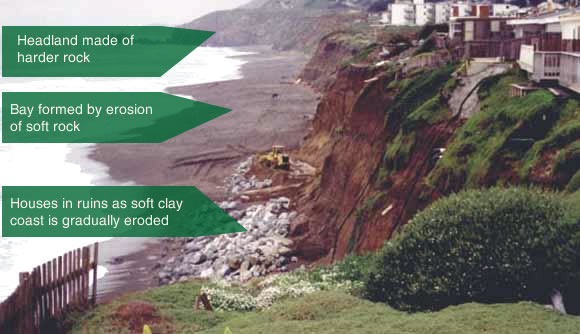One of the most impermanent features of any physical map is the coastline. The edge of the sea is in a state of constant modification, however stable the hinterland may be.
Sea cliffs erode, deltas build up, sand bars and beaches shift. Around the world's coasts, conditions have not yet stabilized after the changes in sea level that accompanied the last ice age.
In many places, the land is still subsiding, allowing the sea to reach up the valleys and turn hills into islands. In other places the land is gradually rising, freed from the weight of overlying ice that melted many thousands of years ago.
Former beaches and cliffs are now found inland, well above sea level. It may still take thousands of years more before many coastlines become fixed and stable.
The type of coastal landscape that develops depends on whether the land is submerging or emerging, and whether the sea is eroding the land or building it up by deposition.
When submergence and erosion occur together, the sea works its way inland and creates the most spectacular types of coastal landscape.
Erosion by Waves
Waves are the most potent agents of coastal erosion. Their power is threefold, and involves hydraulic action, corrasion and attrition.
1. Hydraulic action is produced by the sheer weight of water flung against the cliffs and rocks, compressing the air in the pores and bursting the rocks apart.
2. Corrasion occurs as the boulders and pebbles suspended in the seawater are hurled against the shore and dragged about on the shallow seabed.
3. During attrition, the boulders and pebbles themselves are ground down to sand by tumbling.
Much of the power of wave action is concentrated on headlands, which are attacked from both sides. Joints and bedding planes in the rocks are forced open and enlarged into caves. Caves on opposite sides of a headland may meet and form a natural arch in the rock. In time the top of the arch (lintel) collapses and leaves the offshore portion of rock standing as a sea stack, which eventually crumbles. This process continues, and the headland is eroded back towards the land. The whole sequence of events may take many thousands of years.
Wave erosion of a cliff usually takes place along a line at the base. The waves cut a horizontal notch in the rock, and the resulting overhang eventually collapses into the sea. Current and wave action clears away the debris and the undercutting continues, resulting in one of the most unstable types of coastline.
The shape of the cliff that is formed depends largely on its geology. Soft, unconsolidated material like sand forms a sloping, crumbling cliff, whereas harder rock such as chalk, with an even composition and texture, forms a fairly smooth vertical surface.
Rocks that are strongly bedded, such as shale, or deeply jointed like granite give irregular cliff profiles because wave erosion is accompanied by other forms of erosion and weathering.
Wave erosion attacks softer rocks and unconsolidated sediments most quickly. As a result, the course of the coastline is determined by the grain of the land.
On a large scale when alternate beds of soft and hard rock run out to sea, the soft rock is eroded into bays while the hard rock forms the headlands, which are thus exposed to wave attack. This is known as an "Atlantic type" coastline.
When the grain of the land is parallel to the coast, erosion results in chains of islands and inlets that follow the coast's direction, resulting in what is known as a "Pacific type" coastline.
The sea also erodes some coastlines by dissolving the rocks. This erosive effect is relatively unimportant, however, because most types of rocks are insoluble in seawater. The rocks most vulnerable to the sea's chemical action are those with a high calcareous content, such as limestones.
People's Effect on Coasts
Coastal erosion is often an inconvenience or even a hazard to people, both through the loss of property and the danger to life.
Most attempts to prevent it, however, merely introduce another factor into an already complex and little understood process.
Groynes erected to prevent sand from being washed along a beach deplete the next beach of its sand.
Breakwaters built to provide a sheltered anchorage upset the current pattern and lead to the formation of sandbanks where they are neither expected nor desired.
The power of waves is often greatly underestimated when constructing sea walls, and structures that are supposed to withstand the sea for hundreds of years may last only a decade.
